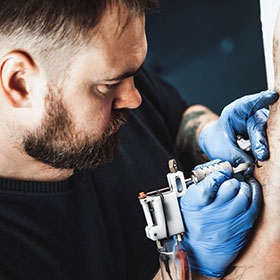No, henna tattoos do not hurt. The process is painless.
Henna tattoos involve applying a natural dye to the skin’s surface. Henna tattoos are a popular form of body art. They have been used for centuries in various cultures. This art form is known for its intricate designs and temporary nature.
Unlike traditional tattoos, henna does not use needles. The dye is made from the leaves of the henna plant. This makes the process completely pain-free. The paste is applied to the skin using a cone or brush. It then dries and stains the skin, creating beautiful patterns. Henna tattoos are a fun and safe way to adorn your body. They can be a great choice for those who want to try body art without the commitment or pain of permanent tattoos.
Introduction To Henna Tattoos
Henna tattoos have a long history. People have used henna for over 5,000 years. It began in ancient Egypt and India. Both cultures loved its beauty. They used it for special events. Even today, henna is still popular.
Henna carries deep meaning in many cultures. In weddings, brides often get henna tattoos. It symbolizes joy and happiness. During festivals, henna is also used. It’s a way to celebrate and show love. Henna brings people together.
What Are Henna Tattoos?
Henna tattoos use a paste made from natural ingredients. The main ingredient is henna leaves. These leaves are dried and ground into a powder. Water, lemon juice, and essential oils are added. This mixture creates a smooth paste. Henna is safe for the skin. It is free from harmful chemicals. People have used henna for centuries.
The application process is simple. First, clean your skin. Next, use a cone or brush to apply the paste. The design can be intricate or simple. Let the paste dry for a few hours. The longer it dries, the darker the stain will be. Once dry, gently scrape off the paste. The design will be orange at first. It will darken over the next few days.
Do Henna Tattoos Hurt?
Henna tattoos are applied with a paste. The paste feels cool on the skin. The process is painless. No needles are used. The artist uses a cone or brush. The sensation is gentle. It is like someone drawing on you. Some people find it relaxing.
Permanent tattoos use needles. They puncture the skin. This can be painful. Henna tattoos do not break the skin. There is no pain. The experience is very different. Henna is a great option for those afraid of needles.
Common Myths About Henna Tattoos
Many people think henna tattoos hurt. This is not true. Henna is a natural dye. It doesn’t use needles. Henna paste is applied to the skin. It feels cool and soothing. There is no pain involved. Henna is safe and gentle for most people.
Another myth is that henna tattoos are permanent. Henna tattoos fade over time. They are not like real tattoos. Henna lasts for about 1 to 3 weeks. It fades as the skin sheds. You can enjoy henna without worrying about permanent marks.
Safety And Allergic Reactions
Henna tattoos are usually safe, but some may contain potential allergens. These allergens can cause skin reactions. Some people might experience redness, itching, or even blisters. Always check the ingredients before use. Natural henna is safer. Avoid products with PPD (paraphenylenediamine). PPD can cause severe reactions. Always do a patch test first. This helps identify possible allergies. Apply a small amount on your skin. Wait for 24 hours. Look for any reactions. If all is well, proceed with the tattoo.
Ensure the artist uses clean tools. Dirty tools can cause infections. Make sure the henna paste is fresh. Old paste may not work well. Avoid henna near your eyes and mouth. These areas are sensitive. If you feel burning or pain, wash the area immediately. Seek medical help if needed. Always follow aftercare instructions. Keep the tattoo area dry for a few hours. Avoid scrubbing the tattooed area. This helps the design last longer.
Henna Tattoo Aftercare
Keep the henna paste on your skin for at least 4 hours. This helps the color set. Avoid washing the area during this time. Cover the henna with a breathable wrap if needed. A sock or bandage can work well.
Once the paste dries, it will start to crack. Do not pick at the flakes. Let them fall off on their own. This ensures the design stays intact. After the paste flakes off, avoid water for another 12 hours. This helps the stain darken.
Moisturize the henna design daily. Use natural oils like coconut or olive oil. This keeps the skin hydrated. Avoid exfoliating the area. Scrubbing can fade the design faster.
Protect the henna from water. Especially during the first 24 hours. Avoid swimming or long showers. Chlorine and saltwater can reduce the stain. Wear gloves if you need to wash dishes. This helps maintain the design.
Choosing The Right Henna Artist
Reading reviews can help you pick the best artist. Look for positive feedback. This can show skill and good service. Check if the artist uses natural henna. Synthetic henna can cause skin issues. A good artist will have many happy customers.
Ask about their experience. How long have they been doing henna? Find out what type of henna they use. Natural henna is safer. Ask to see their past work. This shows their style and skill. Make sure they clean their tools. This keeps your skin safe.
Conclusion
Henna tattoos rarely cause pain. Most people feel only a slight tingling. The natural dye makes the process gentle on the skin. It’s a safe, non-invasive way to enjoy body art. Whether for fun or tradition, henna tattoos offer a beautiful, temporary design.
So, don’t worry about pain. Embrace the experience and enjoy your unique henna tattoo. It’s a delightful way to express yourself without discomfort.

